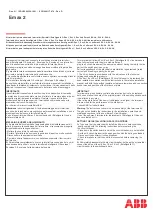
58
Instruction Booklet
IB131006EN
Effective March 2019
Instructions for installation,
operation, and maintenance of type
VCP-W vacuum circuit breakers
EATON
www.eaton.com
6.15 Troubleshooting chart
Symptom
Inspection
Probable defects
Fails to close
• Closing springs not charged
• Control circuit
• Control power (fuse blown or switch off)
• Secondary disconnects
• Motor cut-off switch (poor or burned contacts, lever not operational)
• Terminals and connectors (poor or burned contacts)
• Motor (brushes worn or commutator segment open)
• Mechanism
• Pawls (slipping or broken)
• Ratchet wheel (teeth worn or broken)
• Cam shaft assembly (sluggish or jammed)
• Oscillator (reset spring off or broken)
• Closing spring charged but breaker does
not close
• No closing sound
(close coil does not pick up)
• Control power (fuse blown or switch off)
• Secondary disconnects
• Anti-pump relay Y relay N. C. (contact open or burned or relay picks up)
• Close coil (open or burned)
• Latch check switch (contact open-bad switch or trip bar not reset)
• Auxiliary switch (B contact open or burned)
• Motor cut-off (contacts open or burned)
• Trip coil assembly (clapper fails to reset)
• Closing sound but no close
• Pole shaft (not open fully)
• Trip latch reset spring (damaged or missing)
• Trip bar-d shaft (fails to remain reset)
• Trip latch-hatchet (fails to remain reset)
• Trip floor tripper (fails to remain reset)
• Close latch (binding)
• Close latch roller (binding)
• Trip circuit energized
Undesirably closes
• Control circuit
• Close circuit (CS/C getting shorted)
• Mechanism
• Close release latch (fails to reset)
• Close floor tripper (fails to reset)
Fails to trip
• No trip sound
• Control circuit
• Control power (fuse blown or switch off)
• Secondary disconnect
• Auxiliary switch (A contact not making, poor or burned)
• Trip coil (burned or open)
• Terminals and connections (poor or burned or open)
• Trip mechanism
• Trip clapper (jammed)
• Trip sound but no trip
• Trip mechanism
• Trip bar, trip latch (jammed)
• Pole shaft (jammed)
• Operating rod assembly (broken or pins out)
• Vacuum interrupter
(one or more welded)
Undesirably trips
• Control circuit
• Control Power (CS/T Switch, remains made)
• Mechanism
• Trip coil clapper (not resetting)
• Trip bar or trip latch (poor engagement of mating or worn surfaces)
• Trip bar reset spring (loss of torque)
6.16 End of life procedures
This circuit breaker design does not contain SF
6
, asbestos, or other
hazardous materials that require special handling. On removal
from service, the contacts shall be open and the closing spring
discharged. The unit can be discarded/destroyed in a similar manner
as the switchgear that it is contained within. The breaker raw mate-
rials in general are made from copper, steel, aluminum, and plastic.
6.17 Failure reporting
It is important to learn the field failures. To aid in this process, it is
recommended that IEEE Std C37.10 (section A.1) and the reporting
form IEEE Std 1325 be considered for reporting the breaker failure
event to EATON.















































